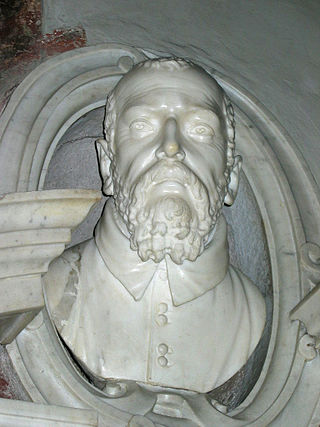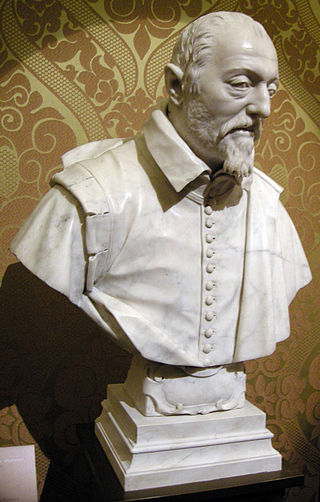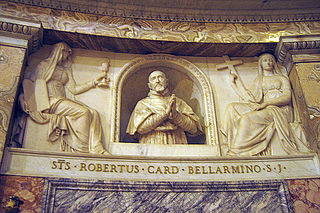
Gian LorenzoBernini was an Italian sculptor and architect. While a major figure in the world of architecture, he was more prominently the leading sculptor of his age, credited with creating the Baroque style of sculpture.

Andrea Bolgi was an Italian sculptor responsible for several statues in St. Peter's Basilica, Rome. Towards the end of his life he moved to Naples, where he sculpted portrait busts. He died in Naples during a plague epidemic.

Two Busts of Cardinal Scipione Borghese are marble portrait sculptures executed by the Italian artist Gian Lorenzo Bernini in 1632. Cardinal Scipione Borghese was the nephew of Pope Paul V, and had commissioned other works from Bernini in the 1620s. Both versions of this portrait are in the Galleria Borghese, Rome.

The Bust of Giovanni Battisti Santoni is a sculptural portrait by the Italian artist Gian Lorenzo Bernini. Believed to be one of the artist's earliest works, the bust forms part of a tomb for Santoni, who was majordomo to Pope Sixtus V from 1590 to 1592. The work was executed sometime between 1613 and 1616, although some have dated the work as early as 1609, including Filippo Baldinucci. The work remains in its original setting in the church of Santa Prassede in Rome.

The Bust of Cardinal Escoubleau de Sourdis is a marble portrait sculpture by the Italian artist Gian Lorenzo Bernini. Executed in 1622, the work depicts François de Sourdis. It is currently in the Musée d'Aquitaine in Bordeaux, France.

The Bust of Francesco I d'Este is a marble portrait bust by the Italian sculptor Gian Lorenzo Bernini. Completed in 1652, the work depicts Francesco I d'Este, Duke of Modena. It is in the Galleria Estense, Modena, Italy. The noble yet detached expression of the face, the extensive drapery and the lavish locks of hair are often taken to be emblematic of the way Bernini represented "absolute monarchs" as seemingly adopting superior poses, oblivious to their surroundings. A painting of the portrait bust, surrounded by various objects, undertaken by the artist Francesco Stringa in the late 1660s is in the Minneapolis Institute of Art.

Medusa is a marble sculpture of the eponymous character from the classical myth. It was executed by the Italian sculptor Gian Lorenzo Bernini. Its precise date of creation is unknown, but it is likely to have been executed in the 1640s. It was first documented in 1731 when presented to the Palazzo dei Conservatori in Rome, and is now part of the collections of the Capitoline Museums.

The bust of Giovanni Vigevano is a marble sculptural portrait by the Italian artist Gian Lorenzo Bernini. The bust was produced between 1617 and 1618, and was then inserted into Vigevano's tomb after he died in 1630. The tomb is in the church of Santa Maria sopra Minerva in Rome.

The Bust of Costanza Bonarelli is a marble sculpture created by Gian Lorenzo Bernini during the 1630's. The piece is now in the Museo Nazionale del Bargello in Florence, Italy. Considered among the most personal of Bernini's works, the bust is of Costanza Piccolomini Bonarelli, the wife of Matteo Bonarelli, who was one of Bernini's disciples and colleagues.

The Italian artist Gian Lorenzo Bernini made two Busts of Pope Paul V. The first is currently in the Galleria Borghese in Rome. 1618 is the commonly accepted date for the portrait of the pope. In 2015, a second bust was acquired by the J. Paul Getty Museum in Los Angeles. It was created by Bernini 1621, shortly after the death of Paul V, and commissioned by his nephew, Cardinal Scipione Borghese. A bronze version of this sculpture exists in the Statens Museum for Kunst, Copenhagen, Denmark.

The Bust of Alessandro Peretti di Montalto is a portrait sculpture by the Italian artist Gian Lorenzo Bernini. Executed in 1622 and 1623, the sculpture is now in the Kunsthalle Hamburg, in Germany. Although possibly mentioned by one of Bernini's early biographers, the bust had been considered lost and therefore makes no appearance in Rudolf Wittkower's catalogue of Bernini’s sculptures of 1955. However, the bust was identified in the 1980s and is now considered an authentic work by Bernini.

The Statue of Pope Clement X is one of the final sculptural works executed by the Italian artist Gian Lorenzo Bernini. It depicts Pope Clement X in the act of benediction, and is housed in the Galleria Nazionale d'Arte Antica in the Palazzo Barberini, Rome.

The Bust of Antonio Cepparelli is a sculptural portrait bust by the Italian artist Gian Lorenzo Bernini. It was executed around 1622. It is in the museum of the church of San Giovanni dei Fiorentini in Rome.

The Bust of Cardinal Roberto Bellarmine is a half-length portrait of Saint Robert Bellarmine by the Italian artist Gian Lorenzo Bernini. It was executed in the years 1621–1624, and unveiled in August 1624. It sits in the Chiesa del Gesù, Rome. It was commissioned by Pope Gregory XV and Cardinal Odoardo Farnese after Bellarmine's death. A tomb (now-destroyed) surrounding the bust was designed by Girolamo Rainaldi, and included sculptural decoration by Bernini's father, Pietro, and Bernini's some-time assistant, Giuliano Finelli.

The Bust of Gabriele Fonseca is a sculptural portrait by the Italian artist Gian Lorenzo Bernini. Executed sometime between 1668 and 1674, the work is located in San Lorenzo in Lucina in Rome, Italy. Gabriele Fonseca was Pope Innocent X's personal physician.

The Bust of Pope Gregory XV is a marble portrait sculpture by the Italian artist Gian Lorenzo Bernini. Executed in 1621, the work is one of three busts of the subject created by Bernini—the other two were bronze casts. The marble bust is on permanent display at the Art Gallery of Ontario, in Toronto. It was donated to the museum by Joey and Toby Tanenbaum.

The Bust of Charles I was a sculptural bust produced by the Italian artist Gianlorenzo Bernini which according to one historian, "set the visual conventions for centuries … [establishing itself as] the official portrait of secular absolutism.". The sculpture was of the then king Charles I of England, who wrote to Bernini that the artist's name was "exalted above those of all men of talent who have exercised your profession.".

Charles I in Three Positions, also known as the Triple Portrait of Charles I, is an oil painting of Charles I of England painted 1635–1636 by the Flemish artist Sir Anthony van Dyck, showing the king from three viewpoints: left full profile, face on, and right three-quarter profile. It is currently part of the Royal Collection.

The Busts of Pope Innocent X are two portrait busts by the Italian artist Gianlorenzo Bernini of Pope Innocent X, Giovanni Battista Pamphili. Created around 1650, both sculptures are now in the Galleria Doria Pamphili in Rome. Like the two busts of Cardinal Scipione Borghese, it is believed that Bernini created a second version of the bust once a flaw was discovered in the first version. There exist several similar versions of the bust done by other artists, most notably Alessandro Algardi.

The Triple Portrait of Cardinal de Richelieu is an oil-on-canvas painting by French artist Philippe de Champaigne, completed c. 1642. The portrait shows Cardinal de Richelieu from three angles: right profile, face on, and left profile. The painting was made as a study for a bust to be made by an Italian sculptor in Rome. It is now held by the National Gallery, London.



















